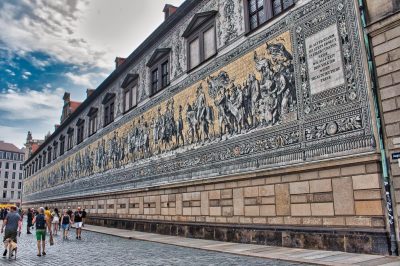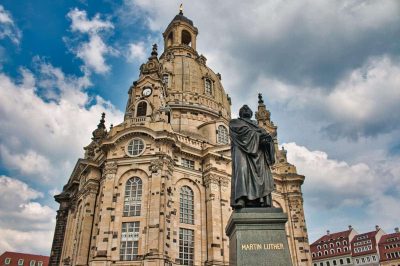Goethe already had the students say in his famous Faust: “Mein Leipzsch lobsch mir, es is ä Kleen-Paris und bildet seine Leudde.” That’s even hard to understand to some Germans, but means something like “Praised be my Leipzig, it’s a little Paris and educates its citizens”. Back then and now too, the city is a beautiful jewel. And if you haven’t been there yet, maybe this article will help you decide. Here are the Top 20 things to do in Leipzig Germany.
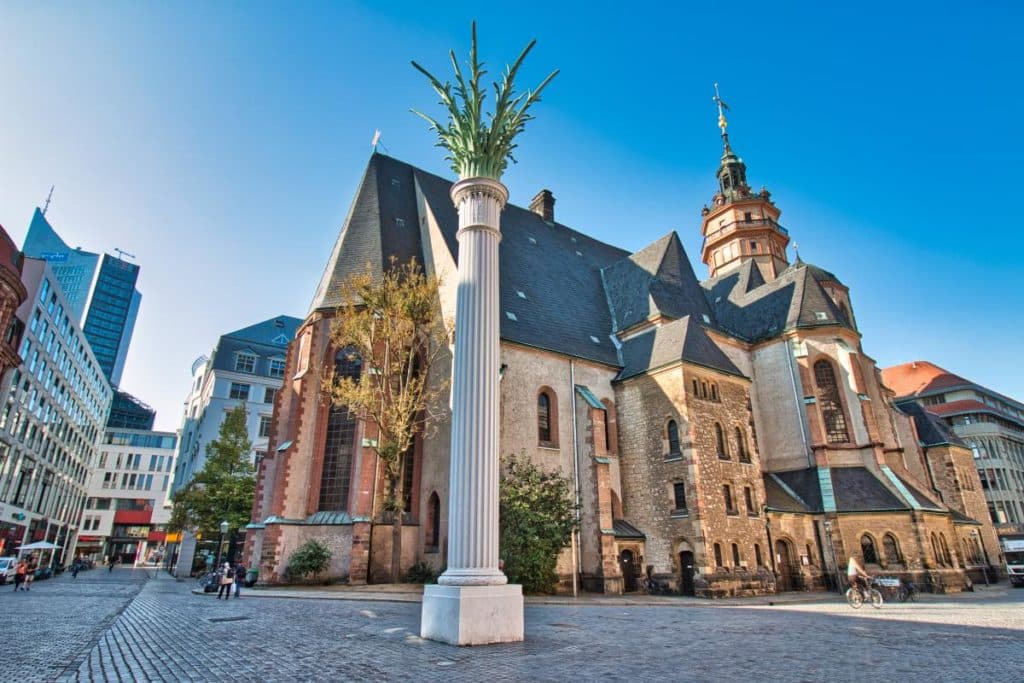
St. Nicholas Church
Leipzig’s largest church was the site of the Peace Prayers in 1989. People gathered here for the Monday Demonstrations that played a key role in the Peaceful Revolution, which toppled the East German communist government. While St. Nicholas Church is a late Gothic hall church on the outside, the interior of the church was beautifully remodeled during the Classicist period. The columns of the church end at the top in the shape of a palm roof, which makes the interior look almost exotic. This so-called “Primitive Hut” is a reference of the time to what was thought to be the original building people lived in. A similar column also stands in front of the church, commemorating the Peaceful Revolution.
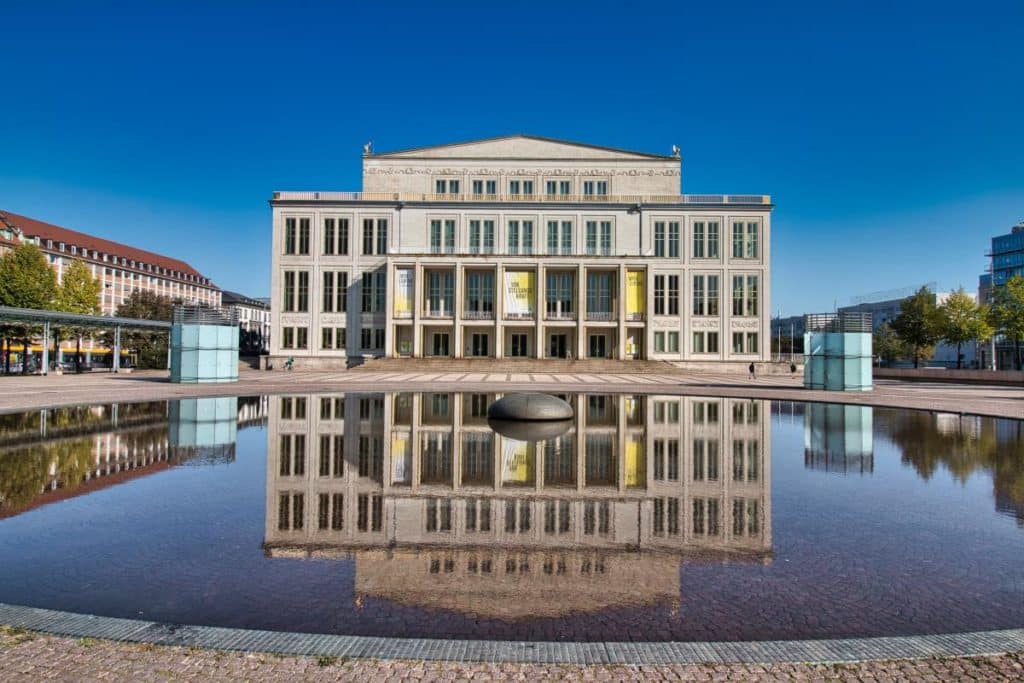
Augustusplatz
It is not only the central square in Leipzig, but also has some of the most important Leipzig sights to offer. On Augustusplatz (Augustus Square) the newly built university with the glass Paulinerkirche can be admired. To the left is the Gewandhaus (see cover image), which is one of the most exciting buildings of GDR postmodernism and where Kurt Masur led his famous orchestra in GDR times. He later became the music director of the New York Philharmonic. Across the street, the Leipzig Opera awaits guests, built in neoclassicism as late as Stalin’s time. The square is one of the most spacious in the city and is rarely blocked by markets or festivals.
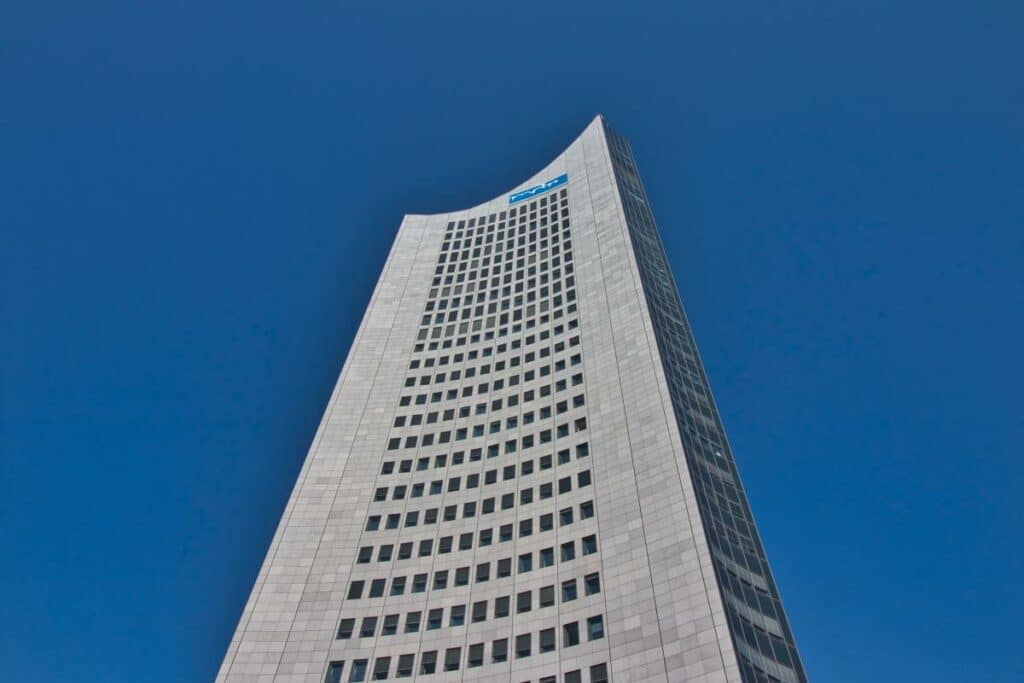
City-Hochhaus
It is an interesting thing that in many Eastern European cities the universities and academies were often the highest buildings in the city. In Leipzig, too, the so called Uniriese (“University Giant”) has been rising in the center of Leipzig since 1972. Until shortly after the reunification it was a building of the university and it’s shape is reminiscent of an open book. From the “Wisdom Tooth” you have a wonderful view of the city – I think the best! Admission to the viewing platform at a height of 120 meters costs 4 euros. Only a few meters below are the restaurants in the “Panorama Tower”. If you want to enjoy the view, you can order a coffee here. The magnificent view comes free of charge.
Adress: Augustusplatz 9, 04109 Leipzig Opening Hours: The viewing platform on the building is open daily from 9 am to 10:30 pm.
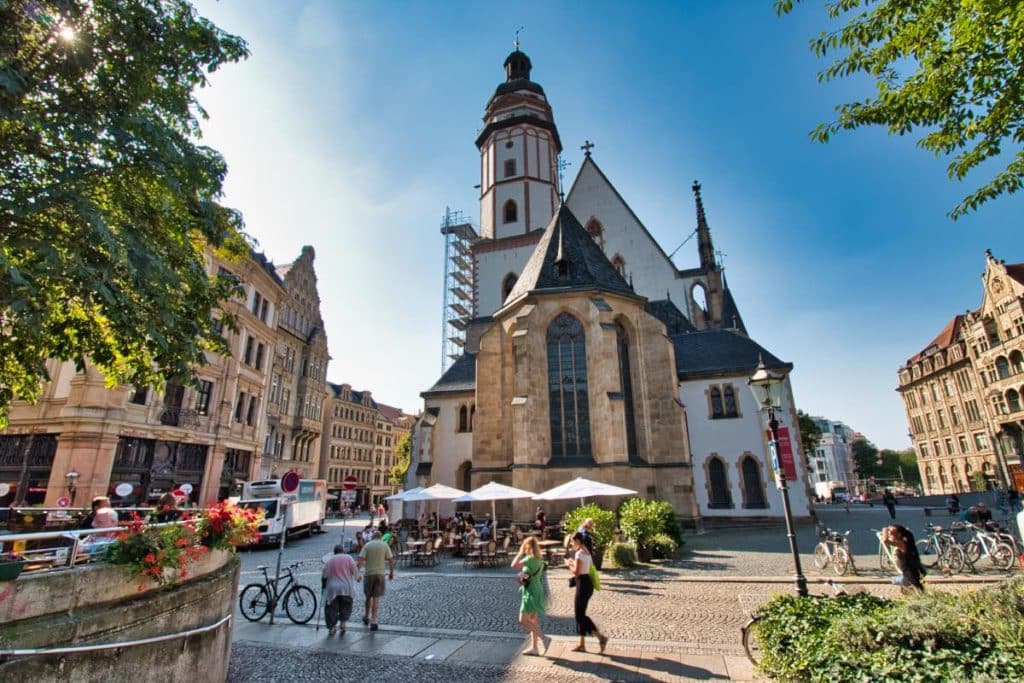
St. Thomas Church
St. Thomas Church (or Thomaskirche in German) is also often called Bach Church. Even though it is dedicated to St. Thomas, most visitors come here because of Johann Sebastian Bach. Although Bach came from Eisenach, he was the cantor of St. Thomas for about 27 years from 1723 to 1750. His remains have also been buried here since 1950. During his time as a cantor, Bach wrote some of his most famous pieces, including the St. Matthew Passion. The world-famous St. Thomas Choir sings at St. Thomas Church. The church is also popular for the organ concerts that regularly take place here.
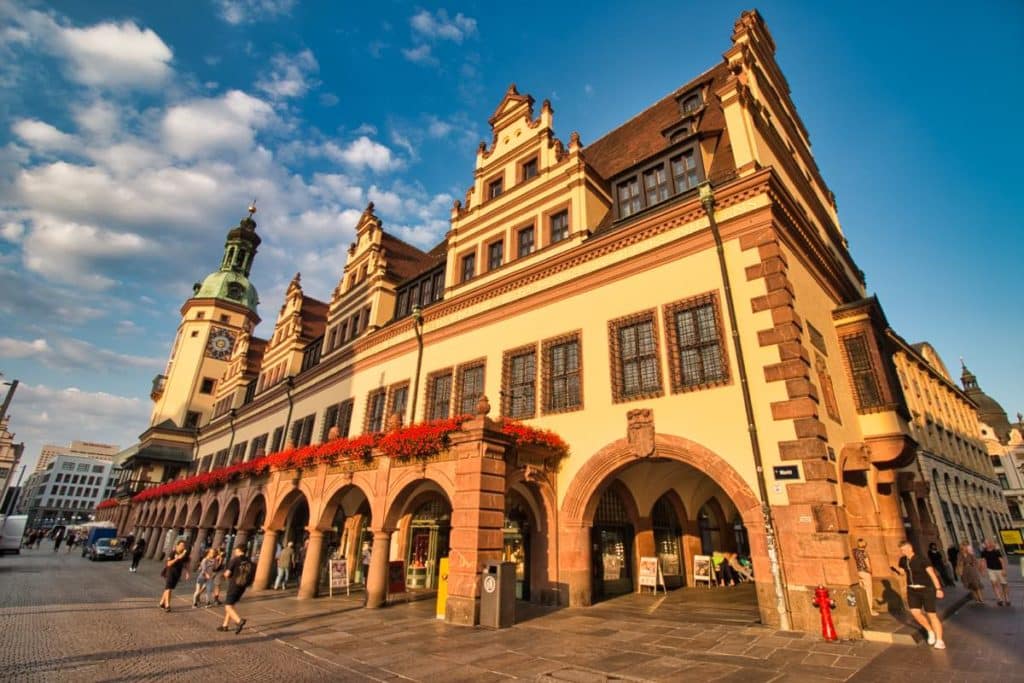
Market square and Old Town Hall
The market square of Leipzig has been the most important trading place of Leipzig since the Middle Ages. Around the market were many important town houses until the Second World War. Some of them were destroyed in the Second World War, but from the royal house and others you can guess the wealth of the city. Until the 19th century, the Leipzig Fair was also held on the market, until it became a sample fair.
The most prominent building is the Old Town Hall in the Renaissance style. This is where the mayor and city council sat until 1905. Then they moved to the New City Hall. Today, the City Tunnel runs under the market. The stop is architecturally quite an eye-catcher and was built where an underground exhibition hall was welcoming guests for the Leipzig Trade Fairs until some years ago. The entrance still bears witness to this today.
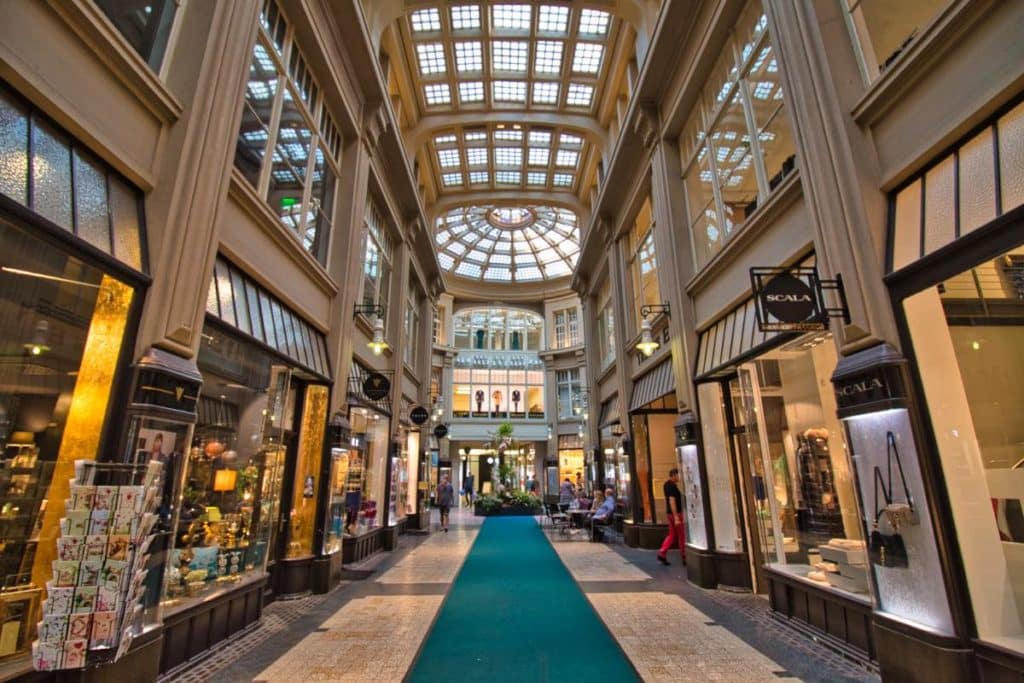
Mädler Passage and Auerbach’s Keller
Before the Second World War, there were dozens of shop passages in Leipzig. Today, the Mädler Passage is the most beautiful of these passages still preserved in Leipzig. Named after a leather manufacturer, today it houses mainly exclusive stores for luxury products. A walk through the glass-roofed hall, which was built from 1912 to 1914, is nevertheless an absolute must for a visit to the trade fair city. Right at the entrance to the Mädlerpassage, opposite the Alte Börse, lies the entrance to Auerbachs Keller. This oldest inn in the city already played an important role in Goethe’s Faust, as evidenced by the statue of Faust at the entrance. Rubbing his shoe is said to bring good luck.
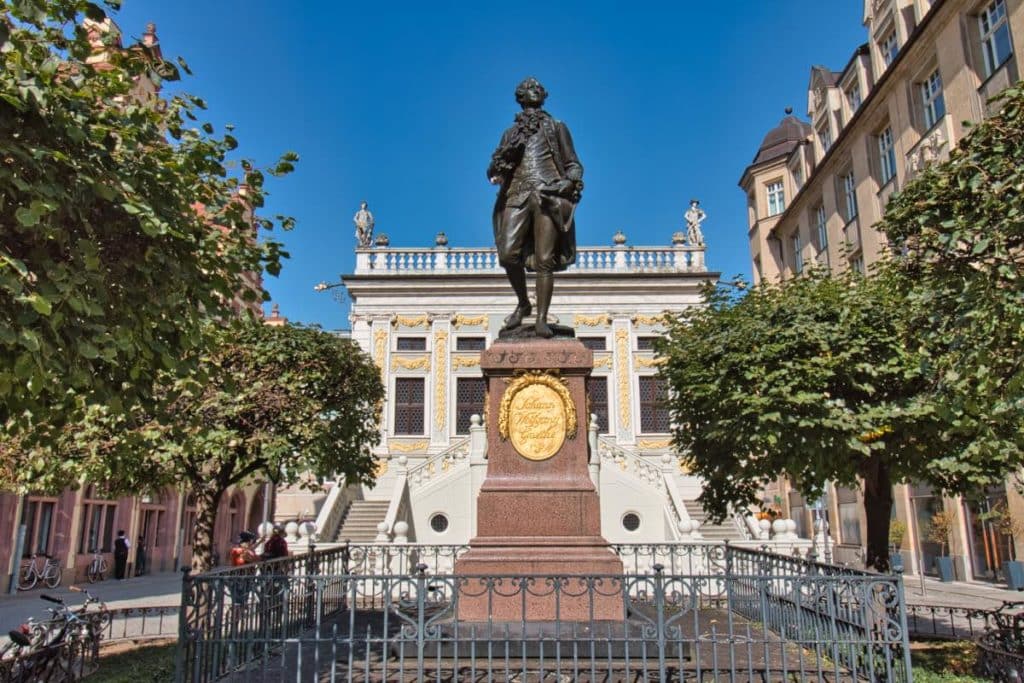
Goethe Monument and Alte Handelsbörse
There is also a monument dedicated to Goethe himself in front of the Alte Handelsbörse and thus opposite Auerbach’s Keller. It depicts Goethe during his years of study, three of which he spent in Leipzig. The monument, together with the Alte Handelsbörse, is a popular photo motif. The baroque building used to house auctions of the Leipzig merchants. Today, it mainly hosts cultural events.
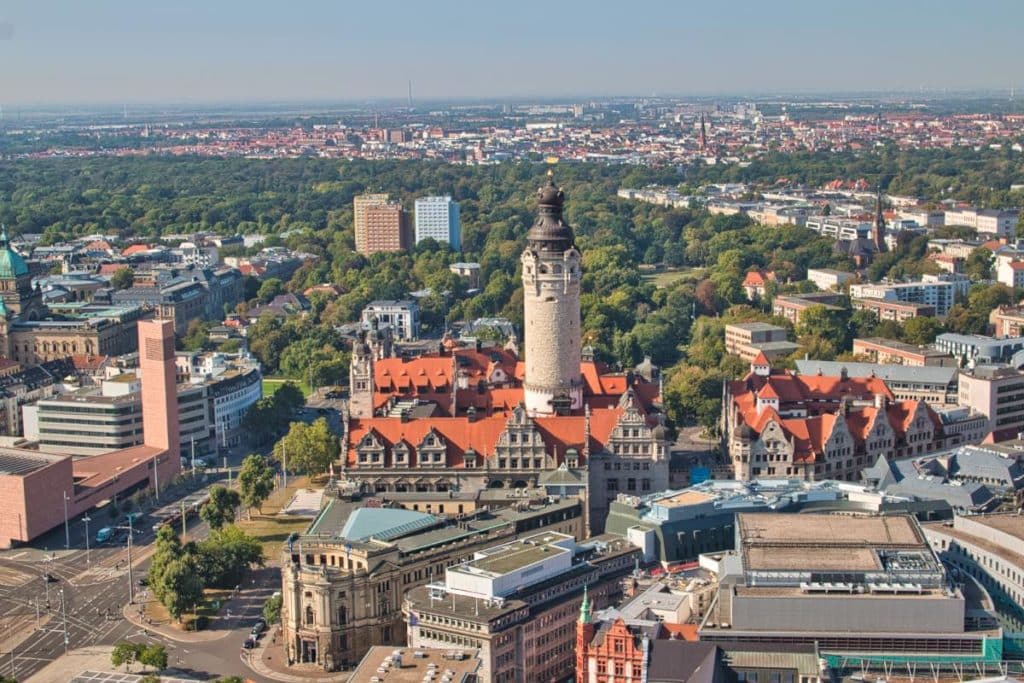
New City Hall
In the past, the Pleißenburg stood on the site of the New Town Hall. It was a fortress and the New Town Hall has a similar appearance. The silhouette of the tower was retained from the castle. The New Town Hall was built between 1899 and 1905 as the seat of the city administration, since the Old Town Hall had become too small. The building, in the style of historicism, features art on the outside as well as the inside. Carl Friedrich Goerdeler, who was involved in Operation Valkyrie, the plans for the assassination of Adolf Hitler on July 20th 1944 and was executed for it in 1945, was the mayor of Leipzig and ruled from the New City Hall from 1930 to 1937. A monument on the southwest side commemorates the resistance fighter.

Round Corner
Today’s Museum in the Round Corner was the Stasi headquarters for the Leipzig district in GDR times and was famous and notorious alike among the citizens. The exhibition shows many items from the agent activities of the Stasi staff. During a guided tour, the guides explain many of the exhibits in detail. I personally found the chairs with the removable fabric covers for obtaining scent samples for sniffer dogs frightening. A visit is worthwhile and should also be combined with the Zeitgeschichtliches Forum, which is the museum for GDR history near the Mädler Passage. Outside Leipzig, in Machern, there is also a former Stasi bunker.
Adress: Dittrichring 24, 04109 Leipzig Opening hours: Daily from 10 am to 6 pm. Admission is free. Guided tours are always at 3 pm. Admission: 5 euros, reduced 4 euros

Tin can and Höfe am Brühl
The tin can (“Blechbüchse”), as the former “Konsument” department store on Brühl has always been called, is one of the architectural features of Leipzig. The striking aluminum facade was listed as a historic monument. Thus, although the building was demolished, the facade was completely restored in the course of the construction of the Höfe am Brühl mall. The old neon signs with “Welcome to Leipzig” in several languages and Goethe’s saying “Mein Leipzig lob ich mir!” (“Praised be my Leipzig”) are also back. But there is still a little melancholy. For the striking prefabricated buildings and the pedestrian bridge that Leipzigers called “The Blue Wonder” have been demolished.
Adress: Brühl 1, 04109 Leipzig Opening Hours: Open mostly from 10 to 20 o’clock. The center “Höfe am Brühl” (Brühl courtyards ) itself are open until 10 pm.
Barfußgässchen
One of the quaintest words from the Leipzig dialect is probably the Drallewatsch, which is the name for the cozy but busy pub street in the center of town. If you want to experience something as a Leipziger, you go to the Drallewatsch. The outdoor seating in the Barfußgässchen stretches through the entire alley and sometimes makes it difficult to walk through. Personally, I meet with friends occasionally in the Barfusz or in the Spizz, where jazz concerts take place quite often. If you like it more “alternative”, it’s best to take a tram and ride it to Karl-Liebknecht-Straße in Südvorstadt or to Karl-Heine-Straße in Plagwitz.

Leipzig Central Station
Until 2013, Leipzig Central Station was the largest terminus station in Europe. However, due to the construction of the City Tunnel, the station lost this status. Nevertheless, the station has 23 tracks and the huge glass-roofed platform hall leaves a lasting impression on every visitor. You should not only visit the station on arrival and departure, but also take some time in between to explore the east and west halls, the platform hall and the art on the building.
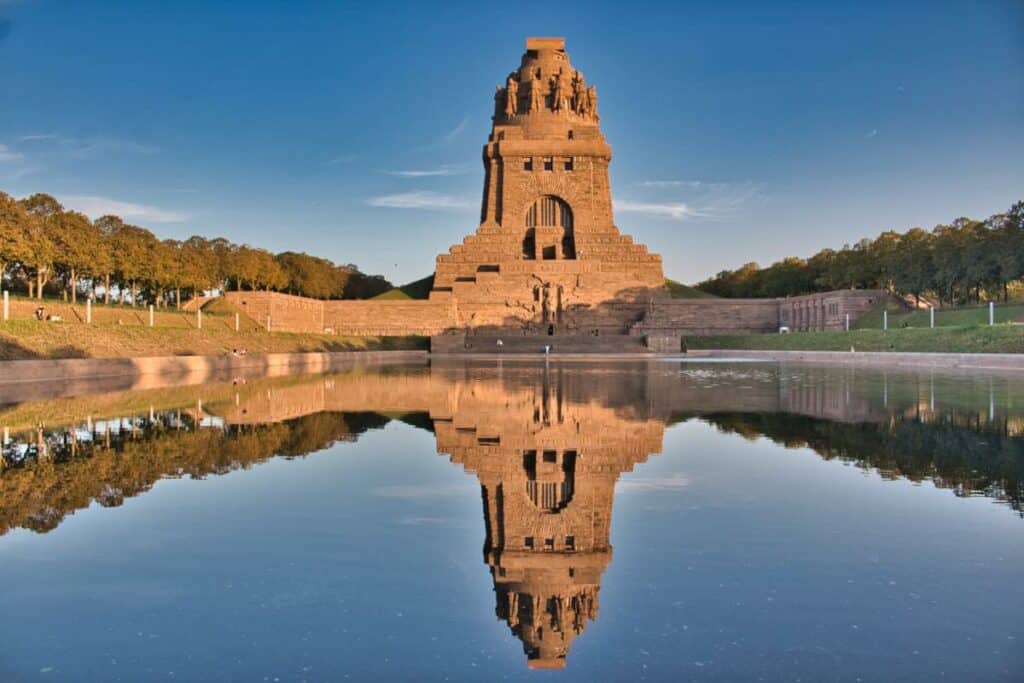
Battle of the Nations Monument
Personally, I find historicism as a architectural style the ugliest in German architecture. The Battle of Nations Monument in Leipzig is a massive stone block that quite impresses you with its sheer size. It was built in 1913 to commemorate the Battle of the Nations near Leipzig, where the Prussians and Russians defeated the French army led by Napoleon. Tens of thousands died in the battle. The monument was built to commemorate them. But the nice thing about it is: the Monument to the Battle of the Nations is quietly located. In front of it there is a pond with fish. The parks invite you to take a walk. The monument is very oppressive from the inside. But the climb to the top is a must do in Leipzig. The view is not quite as great as on the “Uniriese”, but still quite nice.
Adress: Straße des 18. Oktober 100, 04299 Leipzig Opening Hours: Open from April to October 10 am to 6 pm, in other months until 4 pm. Admission: 8 euros, reduced 6 euros. This already includes the ascent to the viewing platform.
Leipzig Zoo
Even though we are not huge fans of zoos, Leipzig Zoo is still a real attraction in the city. With almost 600 species, it is one of the most species-rich zoos in Europe. In zoo rankings, it regularly takes first place in Germany and usually one of the top 3 in Europe. The monkey house, named Pongoland, is considered one of the best of its kind. Here, scientists from the Max Planck Institute for Evolutionary Anthropology observe orangutans, gorillas, chimpanzees and other primates. Many reptiles are on display in the Gondwanaland tropical hall. With more than 1.7 million visitors, Leipzig Zoo is one of the most important Leipzig attractions.
Adress: Pfaffendorfer Straße 29, 04105 Leipzig Opening hours: April and October 9 a.m. to 6 p.m., May to September 9 a.m. to 7 p.m., November to March 9 a.m. to 5 p.m. Admission: 22 euros (winter: 18 euros), reduced 14 euros (winter: 11 euros). There are family tickets and other savings options.
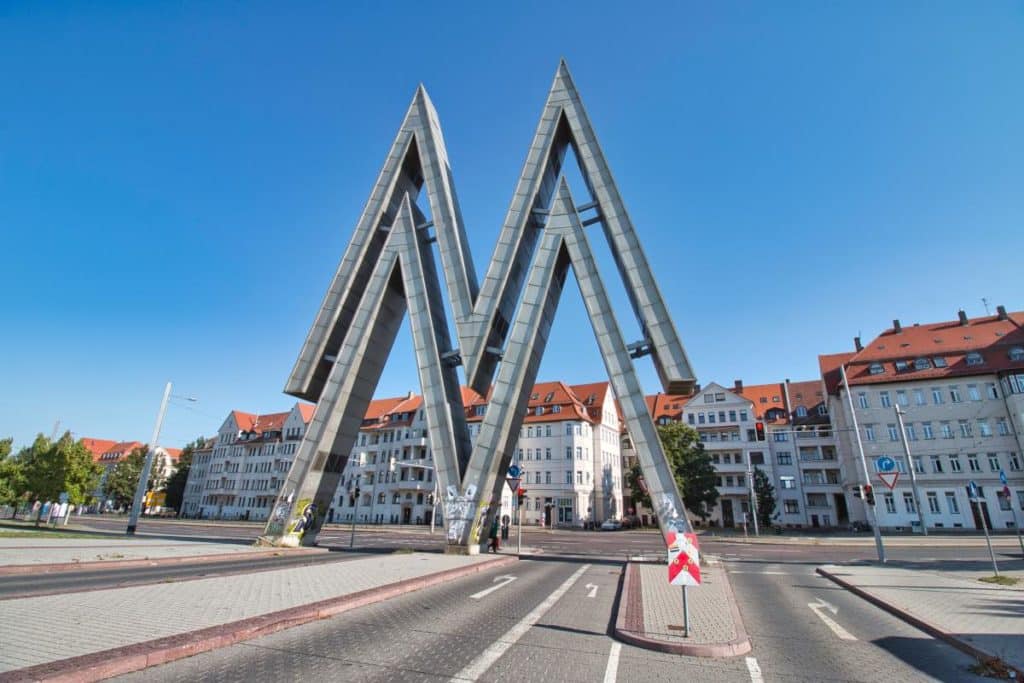
Old Trade Fair and Kohlrabizirkus
East and West met at the Leipzig Trade Fair, especially in GDR times. Here, mainly companies from the Eastern bloc presented their developments and products for Western companies. At the Alte Messe you can still feel a bit of the old glamor. On a tour you will learn more about the history of the Leipzig Fair. Unique are especially the landmark sign of the fair with the double-M and the former Soviet pavilion, which is still crowned by a red star.
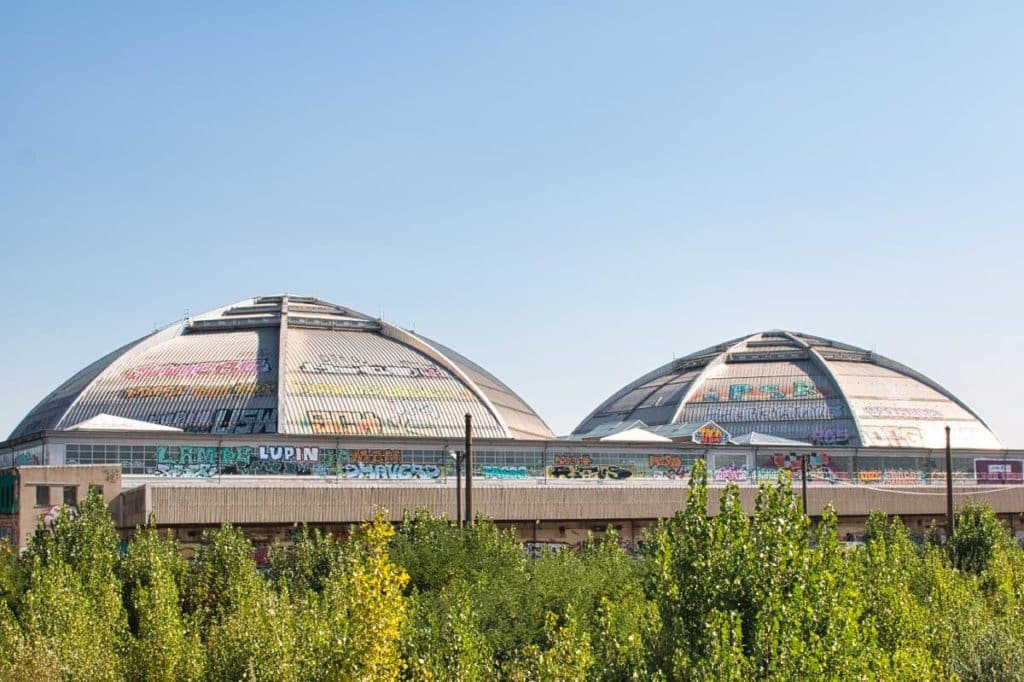
The Kohlrabizirkus (German for cabbage turnip circus because of its form) is an architectural monument, which was even awarded in 2013 by the Federal Chamber of Engineers as a historic landmark of engineering in Germany. The former wholesale market hall is now used as an event and concert hall and is open, for example, during the annual Wave-Gotik-Meeting, the biggest Goth music festival in the world or during the night flea markets there. Today, the Kohlrabizirkus is unfortunately one of the somewhat unnoticed sights of Leipzig. It would be nice if more would be done here again.
Adress: An den Tierkliniken 42, 04103 Leipzig Opening hours: The Kohlrabizirkus is only open for events. One of them is the night flea market. When the next night flea market takes place, you can read here.
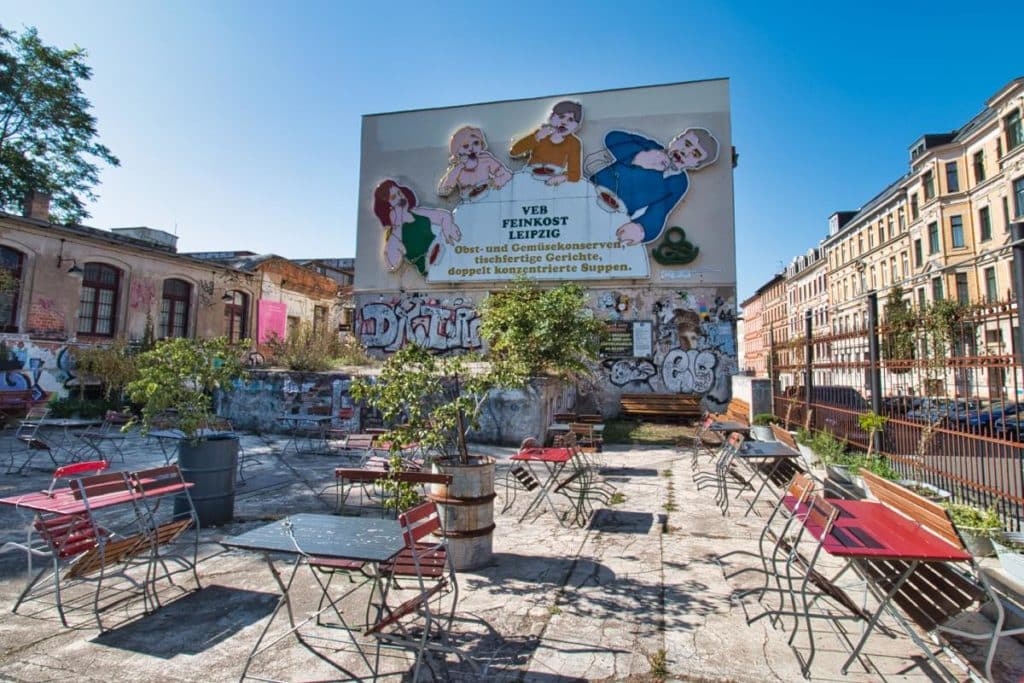
Spoon Family – Neon sign of the former VEB Feinkost
The Spoon Family (“Löffelchenfamilie”) is a neon sign from GDR times in Leipzig. It shows a family sitting at the table and eating with a spoon. The spoon moves through changing lighting. It was advertising the products of the VEB Feinkost which produced delicacies in the GDR and was located in the buildings around the sign. The people of Leipzig love their neon signs. They are said to have been created after SED chairman Walter Ulbricht complained about the darkness in the city after a walk through Leipzig at night. There are other neon signs from GDR times, for example along Windmühlenstraße and at Bayerischer Platz. The Löffelchenfamilie is also a good starting point for a stroll through the alternative stores on the so called Feinkostgelände and along Karl-Liebknecht-Strasse.
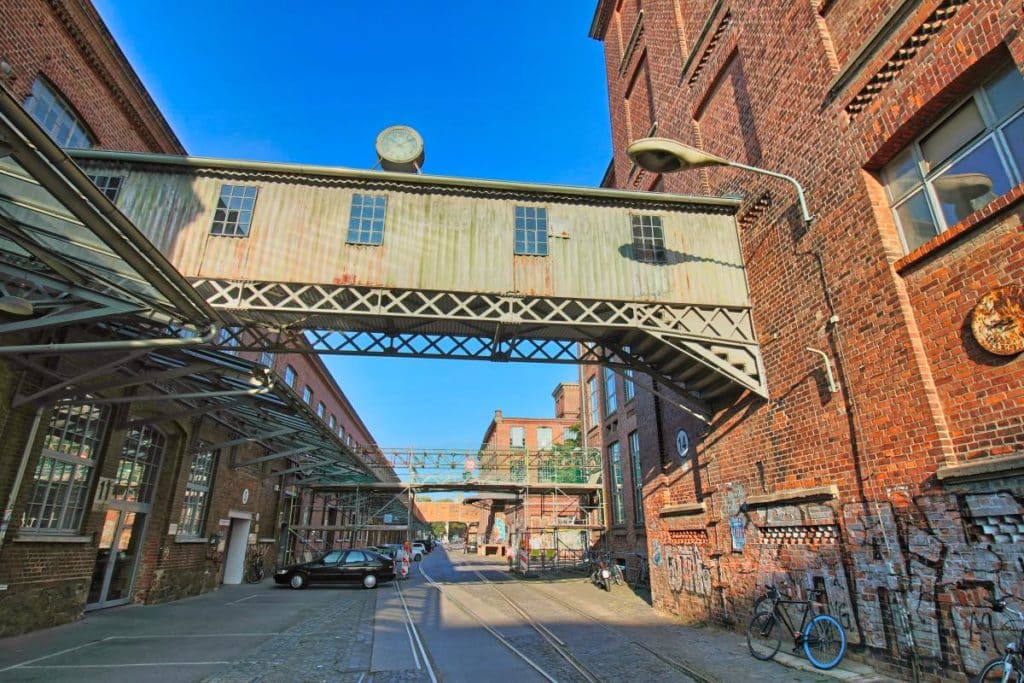
Cotton Mill
The Leipzig Cotton Mill (“Baumwollspinnerei”) was one of the largest factories in the city until 1990. 4000 people worked here at times and produced textiles. After 1990, the machines were switched off in the industrial area from the founding period. Gradually, clubs, stores and restaurants moved in. Companies from the fields of architecture or other arts, have their offices and studios here. In addition, a dozen galleries have settled here and about 100 artists have their studios here. Among them are artists of the New Leipzig School such as Neo Rauch or Tilo Baumgärtel.
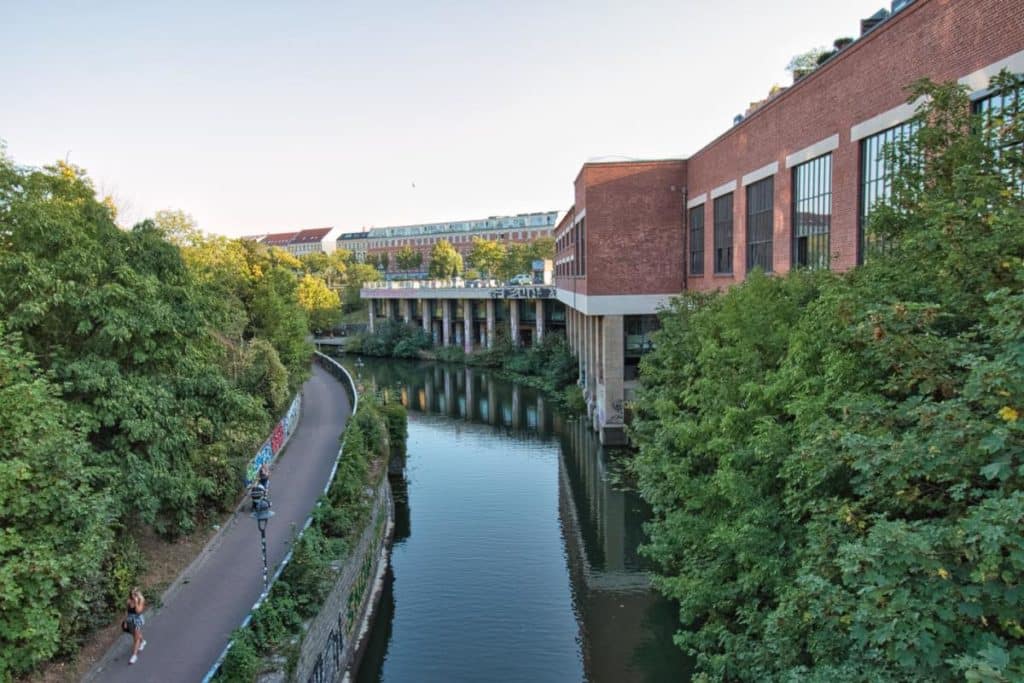
Karl-Heine-Kanal
Once upon a time, the Karl-Heine-Kanal was an industrial canal that connected the factory buildings in Leipzig Plagwitz with the waterways of Central Germany, thus simplifying the delivery and removal of goods. Today, the canal is a popular excursion destination and, together with Karl-Heine-Strasse, represents the city’s alternative cultural scene. Boat trips can be wonderfully organized on the canal. On the shore there is not only a foot and bike path, but also some cafes and restaurants.
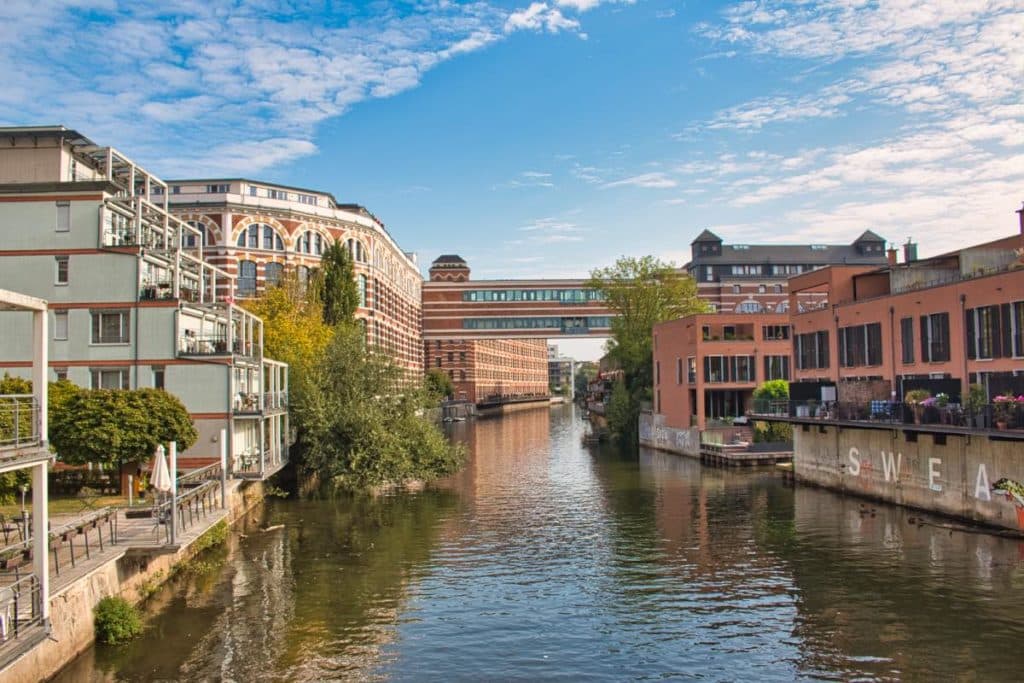
Weiße Elster
The Weiße Elster (“White magpie”) is also one of the most beautiful Leipzig sights from the water side. Between the districts of Plagwitz and Schleußig, there are great views here of the old factory buildings, which are now lofts. On the edge of the Elster basin it is easy to walk and relax. From here, it’s not far to the buildings of the Leipzig Sports Forum, the former German Academy of Physical Culture or the world’s Schrebergarten which are small gardens very typical for German cities.
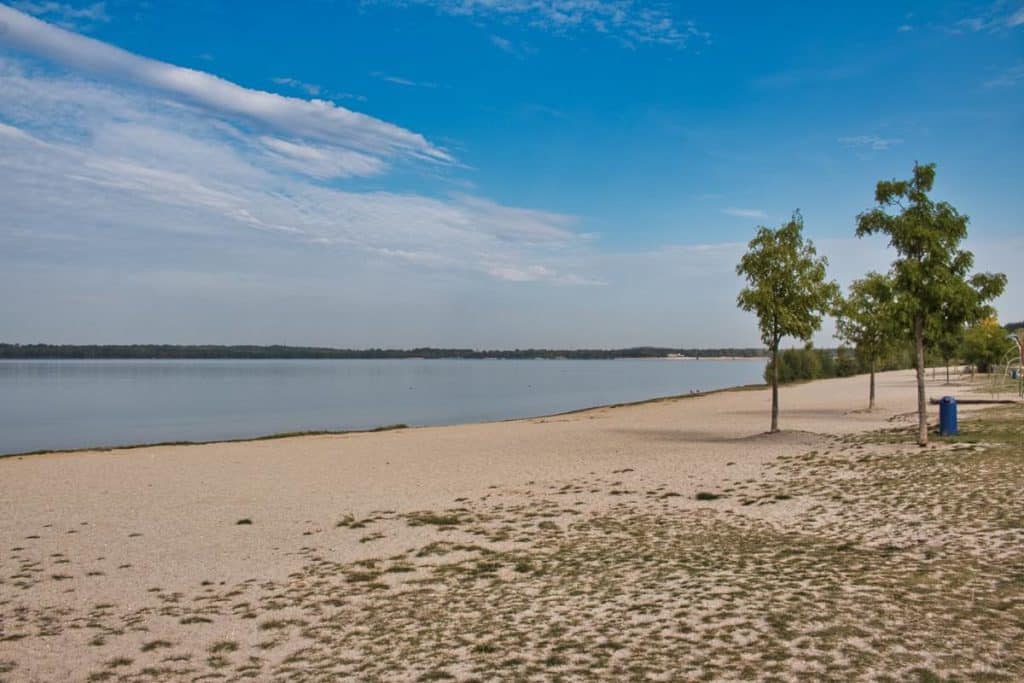
Leipzig Neuseenland with Lake Cospuden
Coal was mined south of Leipzig until the 1990s. The former open-cast mines were then flooded in a renaturation project and today form the Leipzig Neuseenland (literally “New Lake Land”). The first lake to be made accessible was Lake Cospuden, also known as “Cossi” for short. It is one of the most popular destinations for the people of Leipzig. In summer, the bathing beaches are full and the whole city goes to Cossi by bike. The mining park, where old open pit mining equipment is exhibited, is also interesting, even if it is not quite as impressive as Ferropolis. Nevertheless, the Neuseenland is one of the most beautiful Leipzig sights.
Book recommendations
You haven’t had enough of Leipzig yet? Then take a look at our book tips.
No products found.
Very detailed guidebook that will give you a detailed and deep insight into the history of the city and it’s things to see.
The most important sights of the city explained in detail for your visit to the city.
- Lee, Thomas (Author)
Classical guidebook, that takes you to the most beautiful places and shows you the top things to do in Leipzig.
- Hofschroer, Peter (Author)
Great overview about the Battle of Leipzig, that changed the outcome of history.
- Maul, Michael (Author)
This book tells you everything about famous Thomaner Choir and the importance of music to the city.
And, can you think of any other things to do in Leipzig? Feel free to leave us a comment!


